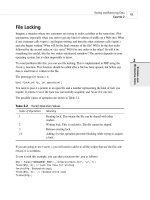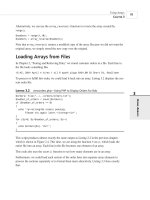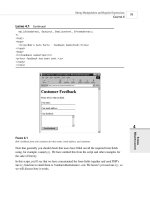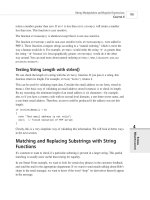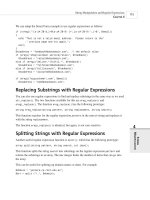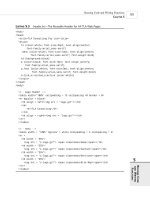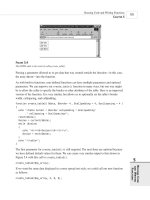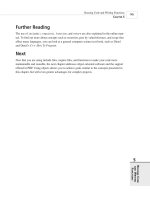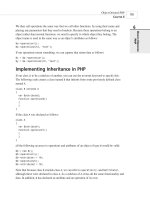Phát triển web với PHP và MySQL - p 15 docx
Bạn đang xem bản rút gọn của tài liệu. Xem và tải ngay bản đầy đủ của tài liệu tại đây (531.41 KB, 10 trang )
We can adapt the Smart Form example to use regular expressions as follows:
if (!eregi(“^[a-zA-Z0-9_]+@[a-zA-Z0-9\-]+\.[a-zA-Z0-9\-\.]+$”, $email))
{
echo “That is not a valid email address. Please return to the”
.” previous page and try again.”;
exit;
}
$toaddress = “”; // the default value
if (eregi(“shop|customer service|retail”, $feedback))
$toaddress = “”;
else if (eregi(“deliver.*|fulfil.*”, $feedback))
$toaddress = “”;
else if (eregi(“bill|account”, $feedback))
$toaddress = “”;
if (eregi(“bigcustomer\.com”, $email))
$toaddress = “”;
Replacing Substrings with Regular Expressions
You can also use regular expressions to find and replace substrings in the same way as we used
str_replace(). The two functions available for this are ereg_replace() and
eregi_replace(). The function ereg_replace() has the following prototype:
string ereg_replace(string pattern, string replacement, string search);
This function searches for the regular expression pattern in the search string and replaces it
with the string replacement.
The function eregi_replace() is identical, but again, is not case sensitive.
Splitting Strings with Regular Expressions
Another useful regular expression function is split(), which has the following prototype:
array split(string pattern, string search, int [max]);
This function splits the string search into substrings on the regular expression pattern and
returns the substrings in an array. The max integer limits the number of items that can go into
the array.
This can be useful for splitting up domain names or dates. For example
$domain = “yallara.cs.rmit.edu.au”;
$arr = split (“\.”, $domain);
String Manipulation and Regular Expressions
C
HAPTER 4
4
S
TRING
M
ANIPULATION
115
06 7842 CH04 3/6/01 3:41 PM Page 115
while (list($key, $value) = each ($arr))
echo “<br>”.$value;
This splits the host name into its five components and prints each on a separate line.
Comparison of String Functions and Regular
Expression Functions
In general, the regular expression functions run less efficiently than the string functions with
similar functionality. If your application is simple enough to use string expressions, do so.
Further Reading
The amount of material available on regular expressions is enormous. You can start with the
man page for regexp if you are using UNIX and there are also some terrific articles at
devshed.com and phpbuilder.com.
At Zend’s Web site, you can look at a more complex and powerful email validation function
than the one we developed here. It is called MailVal() and is available at
/>Regular expressions take awhile to sink in—the more examples you look at and run, the more
confident you will be using them.
Next
In the next chapter, we’ll discuss several ways you can use PHP to save programming time and
effort and prevent redundancy by reusing pre-existing code.
Using PHP
P
ART I
116
06 7842 CH04 3/6/01 3:41 PM Page 116
CHAPTER
5
Reusing Code and Writing
Functions
07 7842 CH05 3/6/01 3:35 PM Page 117
Using PHP
P
ART I
118
This chapter explains how reusing code leads to more consistent, reliable, maintainable code,
with less effort. We will demonstrate techniques for modularizing and reusing code, beginning
with the simple use of require() and include() to use the same code on more than one page.
We will explain why these are superior to server side includes. The example given will cover
using include files to get a consistent look and feel across your site.
We will explain how to write and call your own functions using page and form generation
functions as examples.
In this chapter, we will cover
• Why reuse code?
• Using require() and include()
• Introduction to functions
• Why should you define your own functions?
• Basic function structure
• Parameters
• Returning a value
• Pass by reference versus pass by value
• Scope
• Recursion
Why Reuse Code?
One of the goals of software engineers is to reuse code in lieu of writing new code. This is not
because software engineers are a particularly lazy group. Reusing existing code reduces costs,
increases reliability, and improves consistency. Ideally, a new project is created by combining
existing reusable components, with a minimum of development from scratch.
Cost
Over the useful life of a piece of software, significantly more time will be spent maintaining,
modifying, testing, and documenting it than was originally spent writing it. If you are writing
commercial code, you should be attempting to limit the number of lines that are in use within
the organization. One of the most practical ways to achieve this is to reuse code already in use
rather than writing a slightly different version of the same code for a new task. Less code
means lower costs. If software exists that meets the requirements of the new project, acquire it.
The cost of buying existing software is almost always less than the cost of developing an
equivalent product. Tread carefully though if there is existing software that almost meets your
requirements. It can be more difficult to modify existing code than to write new code.
07 7842 CH05 3/6/01 3:35 PM Page 118
Reliability
If a module of code is in use somewhere in your organization, it has presumably already been
thoroughly tested. Even if it is only a few lines, there is a possibility that if you rewrite it, you
will either overlook something that the original author incorporated or something that was
added to the original code after a defect was found during testing. Existing, mature code is
usually more reliable than fresh, “green” code.
Consistency
The external interfaces to your system, including both user interfaces and interfaces to outside
systems, should be consistent. It takes a will and a deliberate effort to write new code that is
consistent with the way other parts of the system function. If you are re-using code that runs
another part of the system, your functionality should automatically be consistent.
On top of these advantages, re-using code is less work for you, as long as the original code
was modular and well written. While you work, try to recognize sections of your code that you
might be able to call on again in the future.
Using require() and include()
PHP provides two very simple, yet very useful, statements to allow you to reuse any type of
code. Using a require() or include() statement, you can load a file into your PHP script.
The file can contain anything you would normally type in a script including PHP statements,
text, HTML tags, PHP functions, or PHP classes.
These statements work similarly to the Server Side Includes offered by many Web servers and
#include statements in C or C++.
Using require()
The following code is stored in a file named reusable.php:
<?
echo “Here is a very simple PHP statement.<BR>”;
?>
The following code is stored in a file called main.php:
<?
echo “This is the main file.<BR>”;
require( “reusable.php” );
echo “The script will end now.<BR>”;
?>
Reusing Code and Writing Functions
C
HAPTER 5
5
REUSING CODE
AND
WRITING
FUNCTIONS
119
07 7842 CH05 3/6/01 3:35 PM Page 119
If you load reusable.php, it probably won’t surprise you when “Here is a very simple
PHP statement.” appears in your browser. If you load main.php, something a little more
interesting happens. The output of this script is shown in Figure 5.1.
Using PHP
P
ART I
120
FIGURE 5.1
The output of main.php shows the result of the require() statement.
A file is needed to use a require() statement. In the preceding example, we are using the file
named reusable.php. When we run our script, the require() statement
require( “reusable.php” );
is replaced by the contents of the requested file, and the script is then executed. This means
that when we load main.php, it runs as though the script were written as follows:
<?
echo “This is the main file.<BR>”;
echo “Here is a very simple PHP statement.<BR>”;
echo “The script will end now.<BR>”;
?>
When using require() you need to note the different ways that filename extensions and PHP
tags are handled.
File Name Extensions and Require()
PHP does not look at the filename extension on the required file. This means that you can
name your file whatever you choose as long as you’re not going to call it directly. When you
use require() to load the file, it will effectively become part of a PHP file and be executed as
such.
07 7842 CH05 3/6/01 3:35 PM Page 120
Normally, PHP statements would not be processed if they were in a file called for example,
page.html. PHP is usually only called upon to parse files with defined extensions such as
.php. However, if you load this page.html via a require() statement, any PHP inside it will
be processed. Therefore, you can use any extension you prefer for include files, but it would be
a good idea to try to stick to a sensible convention, such as .inc.
One thing to be aware of is that if files ending in .inc or some other non-standard extension
are stored in the Web document tree and users directly load them in the browser, they will be
able to see the code in plain text, including any passwords. It is therefore important to either
store included files outside the document tree, or use the standard extensions.
PHP Tags and require()
In our example our reusable file (reusable.php) was written as follows:
<?
echo “Here is a very simple PHP statement.<BR>”;
?>
We placed the PHP code within the file in PHP tags. You will need to do this if you want PHP
code within a required file treated as PHP code. If you do not open a PHP tag, your code will
just be treated as text or HTML and will not be executed.
Using require() for Web Site Templates
If your company has a consistent look and feel to pages on the Web site, you can use PHP to
add the template and standard elements to pages using require().
For example, the Web site of fictional company TLA Consulting has a number of pages all
with the look and feel shown in Figure 5.2. When a new page is needed, the developer can
open an existing page, cut out the existing text from the middle of the file, enter new text and
save the file under a new name.
Consider this scenario: The Web site has been around for a while, and there are now tens, hun-
dreds, or maybe even thousands of pages all following a common style. A decision is made to
change part of the standard look—it might be something minor, like adding an email address
to the footer of each page or adding a single new entry to the navigation menu. Do you want to
make that minor change on tens, hundreds, or even thousands of pages?
Reusing Code and Writing Functions
C
HAPTER 5
5
REUSING CODE
AND
WRITING
FUNCTIONS
121
07 7842 CH05 3/6/01 3:35 PM Page 121
FIGURE 5.2
TLA Consulting has a standard look and feel for all its Web pages.
Directly reusing the sections of HTML that are common to all pages is a much better approach
than cutting and pasting on tens, hundreds, or even thousands of pages. The source code for the
homepage (home.html) shown in Figure 5.2 is given in Listing 5.1.
LISTING 5.1 home.html—The HTML That Produces TLA Consulting’s Homepage
<html>
<head>
<title>TLA Consulting Pty Ltd</title>
<style>
h1 {color:white; font-size:24pt; text-align:center;
font-family:arial,sans-serif}
.menu {color:white; font-size:12pt; text-align:center;
font-family:arial,sans-serif; font-weight:bold}
td {background:black}
p {color:black; font-size:12pt; text-align:justify;
font-family:arial,sans-serif}
p.foot {color:white; font-size:9pt; text-align:center;
font-family:arial,sans-serif; font-weight:bold}
a:link,a:visited,a:active {color:white}
</style>
</head>
<body>
Using PHP
P
ART I
122
07 7842 CH05 3/6/01 3:35 PM Page 122
<! page header >
<table width=”100%” cellpadding = 12 cellspacing =0 border = 0>
<tr bgcolor = black>
<td align = left><img src = “logo.gif”></td>
<td>
<h1>TLA Consulting</h1>
</td>
<td align = right><img src = “logo.gif”></td>
</tr>
</table>
<! menu >
<table width = “100%” bgcolor = white cellpadding = 4 cellspacing = 4>
<tr >
<td width = “25%”>
<img src = “s-logo.gif”> <span class=menu>Home</span></td>
<td width = “25%”>
<img src = “s-logo.gif”> <span class=menu>Contact</span></td>
<td width = “25%”>
<img src = “s-logo.gif”> <span class=menu>Services</span></td>
<td width = “25%”>
<img src = “s-logo.gif”> <span class=menu>Site Map</span></td>
</tr>
</table>
<! page content >
<p>Welcome to the home of TLA Consulting.
Please take some time to get to know us.</p>
<p>We specialize in serving your business needs
and hope to hear from you soon.</p>
<! page footer >
<table width = “100%” bgcolor = black cellpadding = 12 border = 0>
<tr>
<td>
<p class=foot>© TLA Consulting Pty Ltd.</p>
<p class=foot>Please see our <a href =””>legal information page</a></p>
</td>
</tr>
</table>
</body>
</html>
Reusing Code and Writing Functions
C
HAPTER 5
5
REUSING CODE
AND
WRITING
FUNCTIONS
123
LISTING 5.1 Continued
07 7842 CH05 3/6/01 3:35 PM Page 123
You can see in Listing 5.1 that a number of distinct sections of code exist in this file. The
HTML head contains Cascading Style Sheet (CSS) definitions used by the page. The section
labeled “page header” displays the company name and logo, “menu bar” creates the page’s
navigation bar, and “page content” is text unique to this page. Below that is the page footer. We
can usefully split this file and name the parts header.inc, home.php, and footer.inc. Both
header.inc and footer.inc contain code that will be reused on other pages.
The file home.php is a replacement for home.html, and contains the unique page content and
two require() statements as shown in Listing 5.2.
LISTING 5.2 home.php—The PHP That Produces TLA’s Homepage
<?
require(“header.inc”);
?>
<! page content >
<p>Welcome to the home of TLA Consulting.
Please take some time to get to know us.</p>
<p>We specialize in serving your business needs
and hope to hear from you soon.</p>
<?
require(“footer.inc”);
?>
The require() statements in home.php load header.inc and footer.inc.
As mentioned, the name given to these files does not affect how they are processed when we
call them via require(). A common, but entirely optional, convention is to call the partial files
that will end up included in other files something.inc (here inc stands for include). It is also
common, and a good idea, to place your include files in a directory that can be seen by your
scripts, but does not permit your include files to be loaded individually via the Web server.
This will prevent these files from being loaded individually which will either a) probably pro-
duce some errors if the file extension is .php but contains only a partial page or script, or
b) allow people to read your source code if you have used another extension.
The file header.inc contains the CSS definitions that the page uses, the tables that display the
company name and navigation menus as shown in Listing 5.3.
The file footer.inc contains the table that displays the footer at the bottom of each page. This
file is shown in Listing 5.4.
Using PHP
P
ART I
124
07 7842 CH05 3/6/01 3:35 PM Page 124
